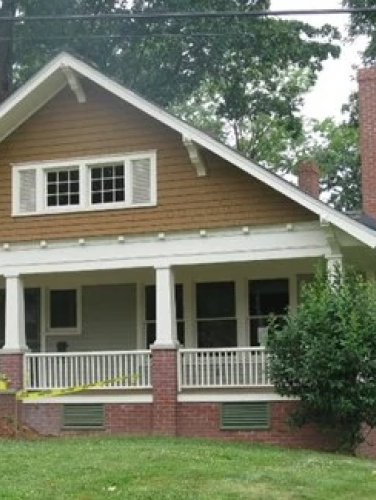
Woodlawn Bungalow
(ca. 1910)
The Woodlawn Bungalow represents the preferred residential form for many early twentieth-century working and middle-class Charlotteans.
1015 Margaret Brown St, Charlotte, NC 28202
Charlotte’s four uptown wards all featured a combination of residential and commercial structures, but Third Ward had more than its share of commercial development. The existence of Southern Railway’s train tracks and the arrival of the Piedmont and Northern Railroad in the early twentieth century precipitated a shift in land use within Third Ward that proved more welcoming to warehousing and commercial, rather than residential, uses.
Property Quick Links
One such commercial use actually spawned one of Third Ward’s few distinctive neighborhoods. Built in 1884, the Victor Cotton Mill (no longer standing) was located near the intersection of Clarkson Street and Westbrook Drive. Around 1907 the owners of the mill (by then known as the Continental Manufacturing Company) decided to develop the adjacent surplus land it owned into the residential Woodlawn neighborhood. Although located inside one of the City’s original four wards, Woodlawn was promoted as a suburb, perhaps due to the success of Dilworth as Charlotte’s first true streetcar suburb. Indeed, Woodlawn was one of Charlotte’s earliest (and smallest) streetcar suburbs. Streetcar lines radiated out from the center of the city, prompting the development of smaller neighborhoods – like Woodlawn, platted along only four streets and served by the West Trade Street streetcar line – along those lines. Some exterior neighborhoods linked to Uptown by the expanding streetcar systems, like Myers Park, Wilmore, and Washington Heights, have survived. Others, such as Oakhurst (now in Plaza Midwood), Piedmont Park (now part of Elizabeth), and Woodlawn (now part of Irwin Park or Third Ward), were absorbed into larger neighborhoods, losing their distinct historic identities.
The Woodlawn Bungalow is an exemplary and well-preserved example of a Craftsman Style bungalow. The bungalow form can trace its origins to India. The form inspired American architects in the creation of the Craftsman Style house, an offshoot of the English Arts and Crafts movement that swept the U.S. in the 1890s, quickly becoming a popular residential style. Used until the early years of the Depression, the bungalow form and elements of the Craftsman Style were particularly popular in the American South, in part because the wide eaves and ample porch were suitable for hot weather. The Craftsman style of art and architecture was also favored because of its focus on simplified details – in contrast to the excessive ornamentation of the Victorian Era – and its resurrection of craftmanship from what many regarded as the toxic impact of the industrial age. The Craftsman philosophy emphasized well-made houses constructed of more commonplace building materials over prefabricated structural elements. Many designers preferred the Craftsman bungalow as a cost-effective means to provide adequate housing, making it the preferred house for many working and middle-class Charlotteans. The Woodlawn Bungalow is also indicative of the pattern of residential turnover in Third Ward’s neighborhoods, as at least ten different individuals or families lived in the house between 1910 and 1943.

